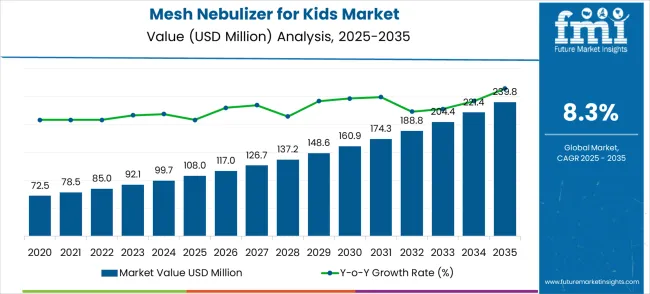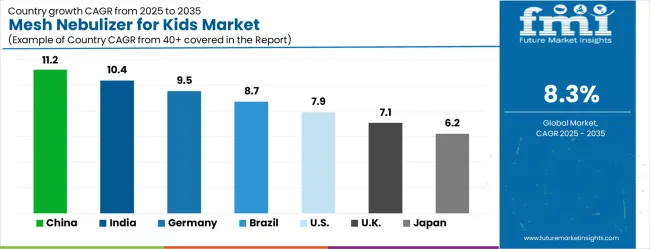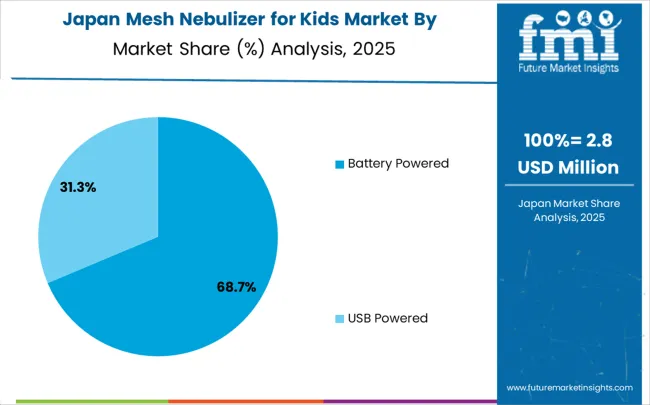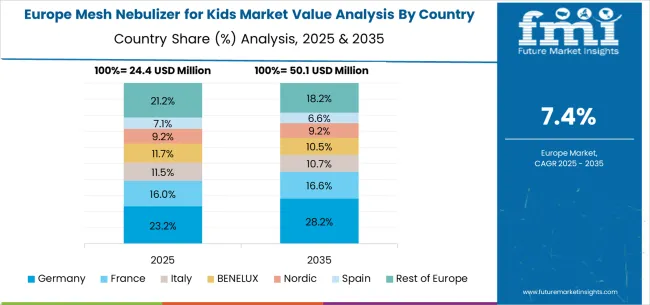The mesh nebulizer for kids market, valued at USD 108.0 million in 2025, is expected to reach USD 239.8 million by 2035, reflecting a CAGR of 8.3%. The absolute dollar opportunity, defined as the incremental revenue generated over the forecast period, amounts to USD 131.8 million. The initial years from 2025 to 2027 mark the foundational growth phase, where pediatric hospitals, clinics, and home care providers begin investing in mesh nebulizer technologies. During this period, the market grows from USD 108.0 million to approximately USD 126.7 million, driven by increasing awareness of pediatric respiratory health, enhanced device efficiency, and ease of use compared to traditional nebulizers.

From 2027 to 2030, the market expands further, reaching an estimated USD 156.3 million. This phase represents a critical segment of absolute dollar opportunity as adoption accelerates among mid-tier healthcare providers and urban households. Parents and caregivers increasingly prioritize devices that reduce medication delivery time and minimize discomfort for children. The cumulative incremental revenue generated during these years contributes significantly to the market opportunity, accounting for nearly 35–40% of the total expected increase through 2035.
| Metric | Value |
|---|---|
| Market Value (2025) | USD 108.0 million |
| Market Forecast Value (2035) | USD 239.8 million |
| Forecast CAGR (2025–2035) | 8.3% |
Between 2030 and 2033, the market growth continues steadily, with the value approaching USD 203.4 million. During this period, the absolute dollar gains are fueled by rising prevalence of pediatric asthma, respiratory infections, and allergic conditions globally. Product innovation, including compact designs, quiet operation, and smartphone-enabled monitoring, drives higher purchase frequency and replacement cycles. Emerging markets in Asia-Pacific and Latin America represent key zones where incremental revenue generation is substantial due to low baseline adoption rates.
By 2035, the market attains USD 239.8 million, confirming the realization of the total absolute dollar opportunity of USD 131.8 million over the decade. Growth is concentrated not only in device sales but also in value-added services such as maintenance, pediatric care training, and bundled solutions with inhaled medications. Companies targeting underpenetrated regions, focusing on device accessibility, and focusing caregiver convenience will maximize the absolute dollar opportunity. The analysis highlights that while the market CAGR of 8.3% reflects consistent growth, the substantial revenue increments across each half of the decade highlights a robust and expanding opportunity landscape for stakeholders.
Mesh Nebulizer for Kids Market Opportunity Pools
The market is entering a phase of strong growth, driven by demand for pediatric respiratory therapy, childhood chronic disease management expansion, and evolving family care and technology standards. By 2035, these pathways together can unlock USD 58-78 million in incremental revenue opportunities beyond baseline growth.
Pathway A -- Pediatric Asthma Leadership (Childhood Asthma Management) The asthma segment already holds the largest share due to its widespread prevalence and critical treatment needs in children. Expanding pediatric protocols, medication compatibility, and family education programs can consolidate leadership. Opportunity pool: USD 20-28 million.
Pathway B -- Battery Power Innovation (Mobility & Independence) Battery powered devices account for the majority of demand. Growing family focus on child mobility and treatment independence will drive higher adoption of advanced battery-powered pediatric nebulizers. Opportunity pool: USD 16-22 million.
Pathway C -- Home Healthcare & Family Care Growth Home-based pediatric care and family-centered treatment approaches are expanding, especially with chronic disease management focus. Nebulizers designed for home use (child-safe, parent-friendly, reliable) can capture significant growth. Opportunity pool: USD 10-14 million.
Pathway D -- Emerging Market Expansion Asia-Pacific, Middle East, and Latin America present growing demand due to rising pediatric healthcare awareness and respiratory disease recognition. Targeting pediatric networks and family healthcare programs will accelerate adoption. Opportunity pool: USD 8-12 million.
Pathway E -- Cystic Fibrosis & Specialized Applications With growing recognition of mesh nebulizer benefits for complex pediatric respiratory conditions, there is opportunity to develop specialized devices for cystic fibrosis treatment and rare pediatric respiratory diseases. Opportunity pool: USD 6-9 million.
Pathway F -- School & Educational Institution Integration School health programs and educational institution healthcare create opportunities for portable nebulizers designed for school nurse administration and emergency treatment protocols. Opportunity pool: USD 4-6 million.
Pathway G -- Connected Health & Digital Integration Nebulizers with smartphone connectivity, medication reminders, and parent tracking create premium value propositions for chronic pediatric disease management programs. Opportunity pool: USD 3-4 million.
Pathway H -- Clinical Services & Family Support Comprehensive family training, pediatric support programs, and medication optimization services create recurring value streams beyond device sales for pediatric respiratory care. Opportunity pool: USD 2-3 million.
Why is the Mesh Nebulizer for Kids Market Growing?
Market expansion is being supported by the rapid increase in pediatric respiratory disease prevalence worldwide and the corresponding need for child-friendly medication delivery devices that provide superior nebulization performance and treatment compliance. Modern pediatric respiratory care relies on consistent medication delivery quality and child acceptance to ensure optimal therapeutic outcomes including childhood asthma management, pediatric COPD treatment, and cystic fibrosis care. Even minor medication delivery challenges can require comprehensive treatment protocol adjustments to maintain optimal patient outcomes and family compliance.
The growing complexity of pediatric respiratory therapy requirements and increasing demand for home-based pediatric care solutions are driving demand for mesh nebulizer devices from certified manufacturers with appropriate pediatric capabilities and child safety expertise. Pediatric healthcare providers are increasingly requiring documented medication delivery efficiency and child-friendly design features to maintain treatment quality and patient compliance. Clinical specifications and pediatric standards are establishing standardized nebulization procedures that require specialized mesh technology and trained pediatric healthcare professionals.
The market is segmented by power type, application, and region. By power type, the market is divided into battery powered and USB powered. Based on application, the market is categorized into asthma, COPD, cystic fibrosis, and others. Regionally, the market is divided into North America, Europe, East Asia, South Asia & Pacific, Latin America, and Middle East & Africa.

In 2025, the battery powered mesh nebulizer for kids segment is projected to capture around 68% of the total market share, making it the leading product category. This dominance is largely driven by the widespread adoption of portable power solutions that provide optimal mobility and independence for pediatric patients and their families, catering to a wide variety of child-centered respiratory care applications. The battery powered nebulizer is particularly favored for its ability to deliver effective medication administration without dependence on electrical outlets, ensuring treatment continuity during travel, school activities, and outdoor situations. Pediatric hospitals, home healthcare providers, school nurses, and families increasingly prefer battery-powered devices, as they meet demanding portability requirements without imposing location restrictions or power source dependencies. The availability of well-established battery technologies, along with comprehensive safety certifications and technical support from leading pediatric medical device manufacturers, further reinforces the segment's market position. This power type benefits from consistent demand across regions, as it is considered an essential solution for families requiring reliable pediatric respiratory therapy that accommodates active childhood lifestyles. The combination of mobility excellence, independence enablement, and family convenience makes battery powered mesh nebulizers for kids a preferred choice, ensuring their continued dominance in the pediatric respiratory care device market.

The asthma segment is expected to represent 52% of mesh nebulizer for kids demand in 2025, highlighting its position as the most significant application sector. This dominance stems from the high prevalence of childhood asthma globally and the critical need for effective bronchodilator and corticosteroid delivery in pediatric asthma management protocols. Pediatric asthma patients often require frequent medication administration that must be delivered efficiently to developing respiratory systems throughout various treatment situations, requiring child-friendly and reliable nebulization equipment. Mesh nebulizers for kids are particularly well-suited to asthma care due to their ability to generate consistent fine particle aerosols that penetrate effectively to pediatric airways while maintaining child acceptance and compliance, even during acute episodes or daily maintenance therapy. As childhood asthma prevalence continues to rise globally and healthcare systems focuses improved pediatric self-management and family involvement, the demand for child-specific mesh nebulizers continues to grow. The segment also benefits from increased awareness within the pediatric respiratory care community, where providers are increasingly recognizing portable nebulization as essential for optimal childhood asthma control and quality of life maintenance. With pediatric asthma patients requiring both emergency relief and daily maintenance treatments adapted to school schedules and family routines, mesh nebulizers for kids provide an essential solution to maintain effective medication delivery while enabling normal childhood activities and development. The growth of school-based asthma management programs, coupled with increased focus on family-centered care and pediatric patient compliance, ensures that asthma applications will remain the largest and most stable demand driver for mesh nebulizers for kids in the forecast period.
The Mesh Nebulizer for Kids market is advancing steadily due to increasing prevalence of pediatric respiratory diseases and growing recognition of mesh nebulization technology advantages over traditional pediatric jet nebulizers. The market faces challenges including higher device costs compared to conventional pediatric nebulizers, need for proper child-safe maintenance and cleaning procedures, and varying pediatric healthcare reimbursement policies across different healthcare systems. Clinical validation efforts and child safety advancement programs continue to influence device development and market adoption patterns.
The growing development of advanced child-friendly design systems is enabling superior pediatric medication delivery with improved child acceptance and enhanced compliance characteristics. Enhanced pediatric-specific technologies and optimized child-safe features provide effective drug delivery while maintaining engaging design elements for young patients. These technologies are particularly valuable for pediatric healthcare providers who require consistent therapeutic performance that can support diverse child patient treatment needs with reliable medication delivery results and improved compliance outcomes.
Modern mesh nebulizer for kids manufacturers are incorporating advanced smart features and child engagement capabilities that enhance treatment compliance and family involvement effectiveness. Integration of advanced child-friendly interfaces and optimized medication tracking systems enables superior therapy management and comprehensive family participation capabilities. Advanced pediatric features support use in diverse care environments while meeting various child safety requirements and family convenience specifications.

| Country | CAGR (2025–2035) |
|---|---|
| China | 11.2% |
| India | 10.4% |
| Germany | 9.5% |
| Brazil | 8.7% |
| United States | 7.9% |
| United Kingdom | 7.1% |
| Japan | 6.2% |
The global market is projected to grow at a CAGR of 8.3% between 2025 and 2035, driven by increasing prevalence of respiratory disorders in children and rising adoption of portable inhalation devices. China leads with 11.2% growth, supported by expanding pediatric healthcare infrastructure and rising awareness of advanced respiratory treatments. India follows at 10.4%, reflecting growing healthcare access, government initiatives for child health, and adoption of homecare nebulization solutions. Germany records 9.5%, driven by demand for efficient and convenient pediatric respiratory devices. Brazil is projected at 8.7%, supported by increasing use of inhalation therapy and growing pediatric patient population. The United States grows at 7.9%, influenced by rising demand for portable and user-friendly nebulizers, while the United Kingdom expands at 7.1% with growing pediatric care adoption. Japan shows 6.2%, reflecting steady market growth and gradual adoption of mesh nebulizer technology.
The report covers an in-depth analysis of 40+ countries; top-performing countries are highlighted below.
China is projected to grow at a CAGR of 11.2% from 2025 to 2035, driven by rising pediatric respiratory health concerns and increased adoption of home healthcare solutions. Awareness among parents regarding efficient and child-friendly nebulization has reinforced demand for mesh nebulizers that deliver precise aerosol dosage with minimal discomfort. Major urban centers such as Beijing, Shanghai, and Guangzhou are witnessing high adoption due to dense population and advanced pediatric care facilities. Domestic manufacturers are focusing on cost-effective, portable, and low-noise devices, while international suppliers provide technologically advanced solutions with superior aerosol performance. Growing government and hospital initiatives promoting pediatric respiratory care further support market expansion.
India is expected to grow at a CAGR of 10.4% between 2025 and 2035, supported by rising prevalence of asthma and respiratory illnesses among children. Adoption is concentrated in states such as Maharashtra, Karnataka, and Tamil Nadu, which host large pediatric healthcare networks and urban clinics. Parents increasingly prefer home-use, portable mesh nebulizers that are safe, efficient, and child-friendly. Indian manufacturers focus on cost-effective solutions suitable for middle-income households, while global companies supply premium devices with advanced aerosol delivery technologies. Increasing awareness campaigns on pediatric respiratory care and air quality concerns contribute to steady demand growth across hospitals and home care settings.
Germany is expected to expand at a CAGR of 9.5% between 2025 and 2035, supported by strong pediatric healthcare infrastructure and high awareness of respiratory health management. Adoption of mesh nebulizers is concentrated in urban centers such as Berlin, Munich, and Hamburg, where hospitals and outpatient clinics focuses precise and safe aerosol therapy for children. German manufacturers produce high-quality, low-noise, and portable devices, while imports from international suppliers offer advanced aerosol control and smart monitoring features. Integration of mesh nebulizers into routine pediatric respiratory therapy protocols and insurance coverage for home care devices reinforces demand and ensures steady market growth.
Brazil is forecasted to grow at a CAGR of 8.7% between 2025 and 2035, driven by rising pediatric asthma cases and increased home healthcare adoption. Adoption of mesh nebulizers is concentrated in São Paulo and Rio de Janeiro, where pediatric healthcare infrastructure is well-developed. Domestic manufacturers focus on cost-effective, compact, and low-noise devices suitable for home and clinic use, while international players provide premium models with efficient aerosol delivery. Awareness campaigns by hospitals and NGOs on pediatric respiratory care have encouraged widespread adoption. Increasing focus on home-based therapy and child-friendly medical devices further supports market growth in Brazil.
The United States is expected to grow at a CAGR of 7.9% between 2025 and 2035, supported by high awareness of pediatric respiratory health and home care preferences. Adoption is concentrated in states such as California, Texas, and New York, where pediatric clinics and hospitals focuses safe and efficient aerosol therapy. Domestic manufacturers offer user-friendly, portable, and low-noise mesh nebulizers for home and clinical use, while international players provide devices with advanced features such as smart dosing and battery efficiency. Rising asthma prevalence and integration of nebulizers into home care plans reinforce steady demand.
The United Kingdom is projected to grow at a CAGR of 7.1% between 2025 and 2035, driven by increasing pediatric respiratory disorders and government-supported awareness programs. Adoption is concentrated in London, Manchester, and Birmingham, where pediatric care centers focuses safety, comfort, and precise aerosol delivery. Domestic manufacturers focus on portable, child-friendly, and low-noise mesh nebulizers, while imports from Europe and the USA offer technologically advanced solutions with improved aerosol efficiency. Integration of home-use devices into pediatric respiratory care plans and school health programs reinforces market growth.

Japan is expected to grow at a CAGR of 6.2% between 2025 and 2035, influenced by rising awareness of pediatric respiratory health and growing home healthcare adoption. Major urban centers including Tokyo, Osaka, and Nagoya have witnessed concentrated adoption due to advanced pediatric clinics and hospitals. Domestic manufacturers focus on compact, portable, and low-noise mesh nebulizers tailored for children, while international suppliers provide devices with enhanced aerosol control and efficiency. Integration into pediatric home care programs and pediatric wards in hospitals strengthens consistent market growth. Japan’s focus on quality, precision, and safety ensures steady adoption across healthcare and home care settings.

The mesh nebulizer for kids market in Europe is forecast to expand from USD 29.0 million in 2025 to USD 64.3 million by 2035, registering a CAGR of 8.3%. Germany will remain the largest market, holding 30.0% share in 2025, easing to 29.5% by 2035, supported by strong pediatric healthcare infrastructure and advanced child respiratory care systems. The United Kingdom follows, rising from 24.0% in 2025 to 24.5% by 2035, driven by children's hospitals and pediatric care initiatives. France is expected to decline slightly from 20.0% to 19.5%, reflecting pediatric healthcare budget constraints. Italy maintains stability at around 16.0%, supported by pediatric facilities and children's respiratory care centers, while Spain grows from 8.0% to 8.5% with expanding pediatric healthcare and child respiratory therapy demand. BENELUX markets ease from 1.5% to 1.4%, while the remainder of Europe hovers near 0.5%--0.6%, balancing emerging Eastern European growth against mature Nordic markets.
The market is defined by competition among specialized pediatric medical device manufacturers, respiratory care companies, and child-friendly therapeutic solution providers. Companies are investing in advanced child-friendly design development, therapeutic effectiveness optimization, portability improvements, and comprehensive family support capabilities to deliver reliable, efficient, and child-engaging respiratory therapy solutions. Strategic partnerships, pediatric innovation, and market expansion are central to strengthening product portfolios and family healthcare presence.
Omron offers comprehensive mesh nebulizer solutions for kids with established pediatric expertise and family-friendly respiratory care capabilities. PARI provides specialized pediatric respiratory therapy equipment with focus on clinical effectiveness and child therapeutic precision. Aerogen delivers advanced pediatric aerosol delivery solutions with focus on child-friendly validation and family applications. Philips specializes in child healthcare technology with advanced pediatric respiratory care device integration.
Medel International offers professional-grade pediatric respiratory therapy devices with comprehensive family support capabilities. Chinavi delivers established child-friendly nebulization solutions with advanced mesh technology applications for pediatric patients. Yuwell provides specialized pediatric respiratory care equipment with focus on child accessibility and family convenience. Honsun, Cofoe Medical, VAPO Healthcare, BMC Medical, and SIMZO offer specialized manufacturing expertise, child device reliability, and comprehensive product development across global and regional pediatric respiratory care market segments.
| Item | Value |
|---|---|
| Quantitative Units | USD 108.0 million |
| Power Type | Battery Powered, USB Powered |
| Application | Asthma, COPD, Cystic Fibrosis, Others |
| Regions Covered | North America, Europe, East Asia, South Asia & Pacific, Latin America, Middle East & Africa |
| Country Covered | China, India, Germany, Brazil, United States, United Kingdom, Japan, and 40+ countries |
| Key Companies Profiled | Omron, PARI, Aerogen, Philips, Medel International, Chinavi, Yuwell, Honsun, Cofoe Medical, VAPO Healthcare, BMC Medical, SIMZO |
| Additional Attributes | Dollar sales by power type and application segment, regional demand trends across major markets, competitive landscape with established pediatric medical device manufacturers and emerging child-friendly technology providers, customer preferences for different power types and pediatric applications, integration with pediatric care protocols and childhood chronic disease management systems, innovations in child-friendly design effectiveness and portable technology features, and adoption of smart connectivity capabilities with enhanced family engagement for improved pediatric therapeutic workflows. |
The global mesh nebulizer for kids market is estimated to be valued at USD 108.0 million in 2025.
The market size for the mesh nebulizer for kids market is projected to reach USD 239.8 million by 2035.
The mesh nebulizer for kids market is expected to grow at a 8.3% CAGR between 2025 and 2035.
The key product types in mesh nebulizer for kids market are battery powered and usb powered.
In terms of application, asthma segment to command 52.0% share in the mesh nebulizer for kids market in 2025.
Explore Similar Insights

Thank you!
You will receive an email from our Business Development Manager. Please be sure to check your SPAM/JUNK folder too.
Chat With
MaRIA